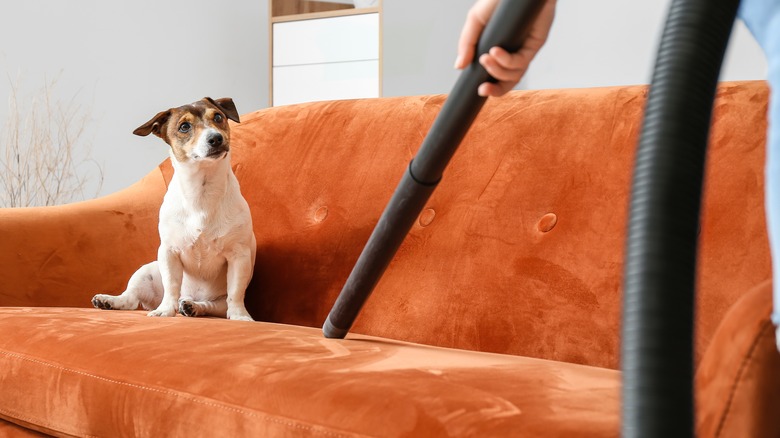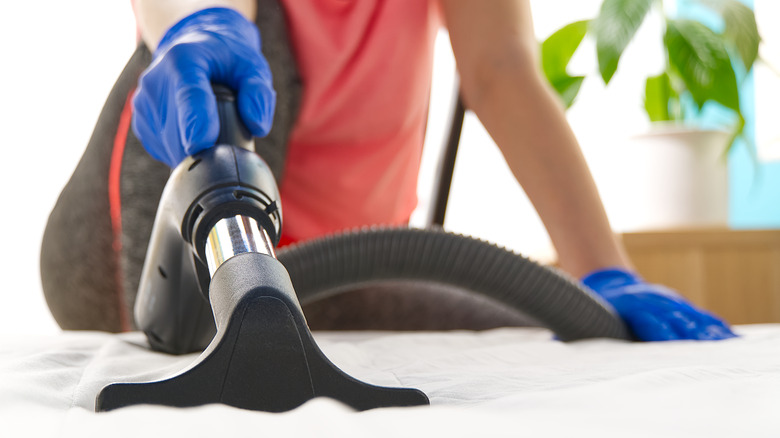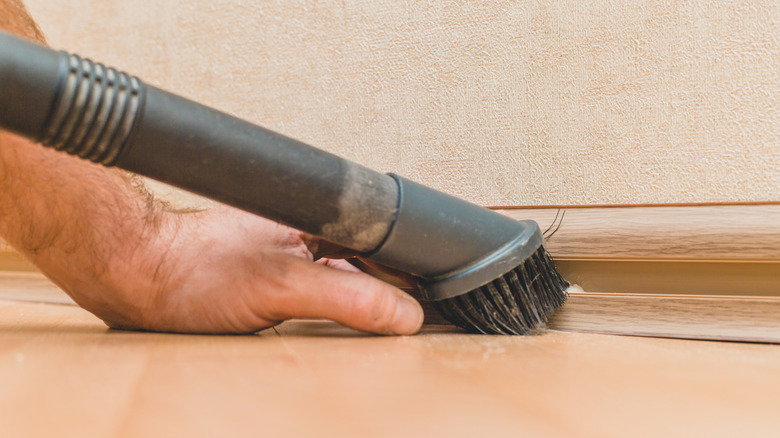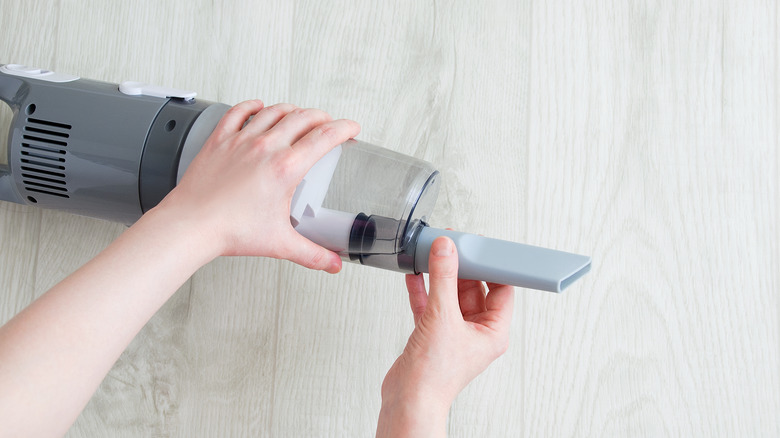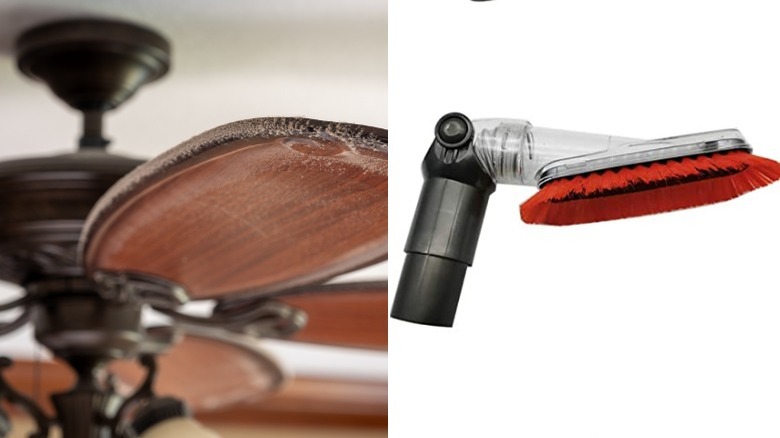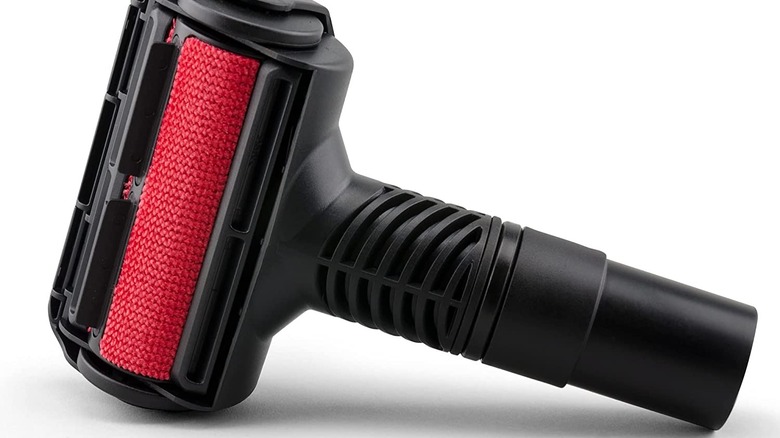Here Are The Right Tasks For Your Vacuum's Attachments
We may receive a commission on purchases made from links.
When you first open up your new vacuum, you'll almost always notice a few attachments held at the neck of the machine or even get a small accessory bag. And often, you may just decide to toss these attachments into the back of your closet, but this is a huge mistake. Using vacuum attachments can increase the efficiency of your vacuuming and help you with tasks you might be struggling with or thought you'd need another gadget to solve.
Once you've got a good handle on which attachments are best suited to which cleaning tasks, you'll find you can get more out of your vacuum and your time spent cleaning. We've broken down the tasks each major type of attachment is best suited for to help you determine which tools are must-haves, depending on your home and lifestyle. Plus, we included what you need to consider if you're looking to buy a new vacuum attachment.
Wide-head upholstery attachments
Have you ever been in a cleaning frenzy when you notice a little cluster of crumbs sitting on your couch cushion? Your first instinct may be to pull the vacuum out and just hold the hose directly to the debris, but you'll quickly realize it's almost impossible to drag the hose along the couch as it tries to gobble up the cushion cover. That is where the hammerhead-style attachment comes in handy.
The wide, flat attachment helps to distribute the suction power over a few inches rather than on a single spot, making it easy to pull the hose along while picking up debris. This is also an excellent tool if you have pets who shed. It can be used on dining chairs, mattresses, and other upholstery, even in your car. This is an essential tool if you regularly vacuum fabric-covered furniture. Some of these tools come with a spinning attachment, similar to the base of your actual vacuum — that's to help prevent hair or string from becoming tangled up in your vacuum's system. Be sure to check this regularly to avoid build-up.
The bristle brush
Did you know your vacuum can help you scrub away sticky debris and hair, as well as suck it up with the right attachment? You just need a bristle brush. Thanks to their flexible but gentle bristles, this tool is handy on baseboards, bathroom drawers, windowsills, air vents, or anywhere else that water and dirt have met, making for tricky extraction. The bristles wiggle the stuck-on crumbs, dust, and hair out of place, and your vacuum takes care of the rest.
It should be noted that it's vitally important to sanitize all of these attachments after they've cleaned a bathroom or pet mess, like near the litter box, but especially when it comes to the bristle brush attachment. Debris and icky bits can easily get stuck in between the fibers, and you can unknowingly track them through the house without careful sanitization and cleaning between uses. These brushes typically have either synthetic nylon or natural horsehair bristles. Horsehair tends to last longer but comes at a higher price, while nylon is less expensive but not as durable.
The narrow, angled tool
With the horsehair brush in your arsenal for narrow spaces like baseboards and the wide-headed attachment for cleaning up the couch, you probably feel like you've got everything covered. But that would be neglecting those pesky crevices between the baseboard and the fridge, and the sinkholes that form between couch cushions, seemingly catching all the coins, crumbs, and debris in your house. For these areas, you need the angled, narrow plastic attachment.
Add this tool to your vacuum hose when it comes to any awkward opening nothing else seems to fit into. We find ourselves using it to get the space between the floor and the oven, behind the toilet, to get into the many nooks and crannies of our car (hello, seatbelt buckles and reclining seats), and of course, between couch cushions. Additionally, because they have no bristles, these attachments are easy to sanitize with a bit of hot water and bleach.
For easier dusting
Did you know your vacuum attachments can even reduce your dusting time? There are angled dust brushes that can get to tall, out-of-reach spots like cob-webbed corners, dusty ceiling fans, crown molding, or the top of the fridge. Unlike a traditional feather duster that tends to spread dust around rather than remove it, the vacuum brush attachment sucks up the dust as it goes, so it doesn't just fall to a lower level. And synthetic disposable dusters suffice at the job, they end up costing more over time as you have to replace them regularly.
These attachments typically come with either fluffy fibers or flexible nylon bristles and flexible joint attachment so you can adjust it to fit many crevices. These are particularly helpful on detachable canister hoses, as they can reach super tall heights, and you won't need to balance on a ladder to clean the house from top to bottom.
A different type of lint roller
Similar to the upholstery cleaner, this microfiber-covered attachment is great on fabrics. Especially if you have pets, you probably find yourself lint rolling everything around you — your dining chairs, sofa, and even your outfits. And while the disposable sticky rolls work at removing hair and lint, they also only work in short bursts and aren't eco-friendly as they create paper waste. That's why this lint rolling vacuum attachment is a must-have.
You can roll it along carpets, rugs, and couches to pick up extra lint. The microfiber pad loosens hair and lint from fabric fibers, making it easier for your vacuum to suck them up. That means you can also use this attachment on hair-covered outfits — just be sure to have them securely weighed down and attached to another surface, or vacuum them while they're being worn, so they aren't accidentally suctioned away. This way, you can stop repurchasing those lint rollers every few months and not leave the house looking like you're wearing your furry friend.
